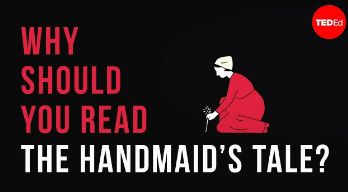(单词翻译:单击)
In Margaret Atwood's near-future novel, "The Handmaid's Tale," a Christian fundamentalist regime called the Republic of Gilead
玛格丽特·阿特伍德的小说《使女的故事》描述了在不久的未来,基督教基要主义政府--基列共和国,
has staged a military coup and established a theocratic government in the United States.
通过军事政变,在美国建立了神权政府。
The regime theoretically restricts everyone,
理论上,这个政体约束每个人,
but in practice a few men have structured Gilead so they have all the power, especially over women.
但事实上,少数男性统治着基列共和国,因此他们拥有至高的权利,尤其是在对待女性方面。
The Handmaid's Tale is what Atwood calls speculative fiction, meaning it theorizes about possible futures.
阿特伍德称《使女的故事》这类小说为推想小说,这类小说构想可能的未来。
This is a fundamental characteristic shared by both utopian and dystopian texts.
这种推想性是乌托邦和反乌托邦小说共有的基本特点。
The possible futures in Atwood's novels are usually negative, or dystopian,
在阿特伍德的小说里,未来通常是消极、反乌托邦的,
where the actions of a small group have destroyed society as we know it.
一部分人的行为已毁灭了我们所熟知的社会。
Utopian and dystopian writing tends to parallel political trends.
乌托邦和反乌托邦的作品通常会影射时下政治走向。
Utopian writing frequently depicts an idealized society that the author puts forth as a blueprint to strive toward.
乌托邦作品通常描述理想社会,是作者描绘出的有朝一日可以实现的未来。
Dystopias, on the other hand, are not necessarily predictions of apocalyptic futures,
与之相反,反乌托邦作品并不一定预言未来发生大灾难,
but rather warnings about the ways in which societies can set themselves on the path to destruction.
而是警示人们社会是如何走向灭亡之路的。
The Handmaid's Tale was published in 1985,
《使女的故事》出版于1985年,
when many conservative groups attacked the gains made by the second-wave feminist movement.
当时很多保守团体抨击第二波女权运动所取得的成就。
This movement had been advocating greater social and legal equality for women since the early 1960s.
这一运动自20世纪60年代初开始,一直倡导女性在社会和法律上更加平等。
The Handmaid's Tale imagines a future in which the conservative counter-movement gains the upper hand
在《使女的故事》中,保守派的反平等运动占了上风,
and not only demolishes the progress women had made toward equality, but makes women completely subservient to men.
不仅摧毁了女性在平等方面所取得的成果,还使女性彻底沦为了男性的附庸。
Gilead divides women in the regime into distinct social classes based upon their function as status symbols for men.
基列共和国将女性分为多个阶层,依据的是她们的职能,她们只是男性地位的象征。
Even their clothing is color-coded.
甚至她们的服装颜色也体现出阶级。

Women are no longer allowed to read or move about freely in public,
女性不允许读书,不可以在公共场所自由行动,
and fertile women are subject to state-engineered rape in order to give birth to children for the regime.
国家策划侵犯有生育能力的女子,从而令她们为政权生育孩子。
Although The Handmaid's Tale is set in the future, one of Atwood's self-imposed rules in writing it was that
虽然《使女的故事》设定在未来,但阿特伍德在撰写此书时自定的规矩之一就是,
she wouldn't use any event or practice that hadn't already happened in human history.
她使用的事件或行为都有历史依据。
The book is set in Cambridge, Massachusetts,
故事设定在马萨诸塞州的剑桥市,
a city that during the American colonial period had been ruled by the theocratic Puritans.
在美国殖民时期,这个城市曾被清教徒统治。
In many ways, the Republic of Gilead resembles the strict rules that were present in Puritan society:
在很多方面,基列共和国与规则森严的清教徒社会类似:
rigid moral codes, modest clothing, banishment of dissenters,
苛刻的道德准则,朴素的服装,驱逐异议人士,
and regulation of every aspect of people's lives and relationships.
人民生活和社会关系的方方面面都受到管制。
For Atwood, the parallels to Massachusett's Puritans were personal as well as theoretical.
对阿特伍德来说,将麻省的清教徒作为原型既包含个人因素,也拥有理论依据。
She spent several years studying the Puritans at Harvard and she's possibly descended from Mary Webster,
她曾花数年在哈佛大学研究清教徒,她有可能是玛丽·韦伯斯特的后裔,
a Puritan woman accused of witchcraft who survived her hanging. Atwood is a master storyteller.
玛丽是一名清教徒女子,曾被指控使用巫术,受绞刑却大难不死。阿特伍德名故事大师。
The details of Gilead, which we've only skimmed the surface of, slowly come into focus through the eyes of its characters,
基列共和国的诸多细节我们尚未提及,但通过人物视角,更多细节慢慢展现,逐渐清晰。
mainly the novel's protagonist Offred, a handmaid in the household of a commander.
小说主要利用主人公奥芙弗雷德的视角,她是将军家的一名侍女。
Before the coup that established Gilead, Offred had a husband, a child, a job, and a normal, middle-class American life.
在基列共和国政变夺权之前,奥芙弗雷德有丈夫、孩子和一份工作,过着普通的美国中产阶级生活。
But when the fundamentalist regime comes into power, Offred is denied her identity, separated from her family,
当基要主义者掌权后,奥芙弗雷德被剥夺了自我,被迫与家人分离,
and reduced to being, in Offred's words, "a two-legged womb for increasing Gilead's waning population."
用她自己的话说,她沦为了“长着两条腿的子宫,为人口稀少的基列共和国添丁。”
She initially accepts the loss of her fundamental human rights in the name of stabilizing the new government.
她起初接受了基本人权的丧失为的是稳定新政府。
But state control soon extends into attempts to control the language, behavior, and thoughts of herself and other individuals.
但是国家的控制很快延伸到对语言、行为和思想的掌控,对所有人都如此。
Early on, Offred says, "I wait. I compose myself. My self is a thing I must compose, as one composes a speech."
早先,奥芙弗雷德说:“我等待着,我要冷静,此刻,我必须理清自我,恰如理清一篇演讲稿。”
She likens language to the formulation of identity.
她把语言比作自我意识的建立。
Her words also acknowledge the possibility of resistance, and it's resistance,
她的话里也包含着抗争的可能性,这种抗争,
the actions of people who dare to break the political, intellectual, and sexual rules,
以及人们勇敢地打破政治、知识和性方面的条条框框,
that drives the plot of the Handmaid's Tale.
推动了《使女的故事》的情节发展。
Ultimately, the novel's exploration of the consequences of complacency, and how power can be wielded unfairly,
归根到底,这部小说探索了傲慢自大的恶果和权利的滥用,
makes Atwood's chilling vision of a dystopian regime ever relevant.
这使得阿特伍德对反乌托邦政权的刻画意义重大,令人不寒而栗。


